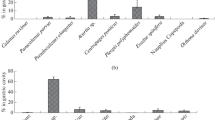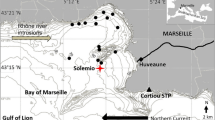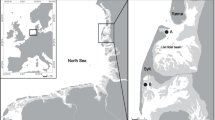Abstract
We analysed feeding interactions between Mnemiopsis leidyi and juvenile Clupea harengus in the Wadden Sea. Biomass, diet overlap, prey selectivity, predation impact and stable isotope composition (C, N) of both species were assessed from June to September 2010. High biomass of C. harengus was found in June and July (wet weight 3.0 ± 1.8 g m−3) followed by a steep decline from August to September (wet weight 0.01 ± 0.01 g m−3), coinciding with a dramatic increase in M. leidyi biomass (wet weight 18.3 ± 16.1 g m−3 during August). These two species showed a high overlap in their respective diets (copepods, meroplankton) during the study period. Predation impact of C. harengus on calanoid copepods was highest in June and July where 84 and 41 % of the standing stock were eaten per day in June and July, respectively. Predation impact of M. leidyi on calanoid copepods was highest in September (16 %). Based on stable isotope analysis C. harengus and M. leidyi were assigned to a trophic level of 3.08 and 2.47, respectively. Furthermore, we assessed the potential of competition between M. leidyi and C. harengus in a mesocosm experiment. Results indicated that at present zooplankton densities intraspecific competition in C. harengus seemed to be greater than interspecies competition with M. leidyi. Due to the low predation impact of M. leidyi and the reduced temporal overlap, competition between M. leidyi and C. harengus during the study period was estimated as low. Nevertheless, considering the high dietary overlap and the inter-annual variation in biomass and occurrence of both species and their zooplankton prey, competition in the Wadden Sea area cannot be excluded.







Similar content being viewed by others
References
Arrhenius F, Hansson S (1993) Food consumption of larval, young and adult herring and sprat in the Baltic Sea. Mar Ecol Prog Ser 96:125–137
Arrhenius F, Hansson S (1994a) In situ food consumption by young-of-the-year Baltic Sea herring Clupea harengus: a test of predictions from a bioenergetics model. Mar Ecol Prog Ser 110:145–149
Arrhenius F, Hansson S (1994b) Erratum re: arrhenius, F., and Hansson, S. 1994. Mar Ecol Prog Ser 110:145–149 Mar. Ecol. Prog. Ser. 114:314
Attrill MJ, Wright J, Edwards M (2007) Climate-related increases in jellyfish frequency suggest a more gelatinous future for the North Sea. Limnol Oceanogr 52:480–485
Batty RS, Blaxter JHS, Richard JM (1990) Light intensity and the feeding behaviour of herring, Clupea harengus. Mar Biol 107:383–388
Bilio M, Niermann U (2004) Is the comb jelly really to blame for it all? Mnemiopsis leidyi and the ecological concerns about the Caspian Sea. Mar Ecol Progr Ser 269:173–183
Birch LC (1957) The meanings of competition. Am Nat 91:5–18
Boersma M, Malzahn AM, Greve W, Javidpour J (2007) The first occurrence of the ctenophore Mnemiopsis leidyi in the North Sea. Helgoland Mar Res 61:153–155
Burrell VG, Van Engel WA (1976) Predation by and distribution of a ctenophore, Mnemiopsis leidyi A. Agassiz, in the York River estuary. Estuar Coast Mar Sci 4:235–242
Condon RH, Graham WM, Duarte CM, Pitt KA, Lucas CH, Haddock SHD, Sutherland KR, Robinson KL, Dawson MN, Decker MB, Mills CE, Purcell JE, Malej A, Mianzan H, Uye S, Gelcich S, Madin LP (2012) Questioning the rise of gelatinous zooplankton in the world’s oceans. Bioscience 62:160–169
Daan R (1989) Factors controlling the summer development of copepod populations in the southern bight of the North Sea. Neth J Sea Res 23:305–322
Deason EE, Smayda TJ (1982) Experimental evaluation of herbivory in the ctenophore Mnemiopsis leidyi relevant to ctenophore-zooplankton-phytoplankton interactions in Narragansett Bay, Rhode Island, USA. J Plankton Res 4:219–236
Elliott M, Dewailly F (1995) The structure and components of European estuarine fish assemblages. Neth J Aquat Ecol 29:397–417
Faasse M, Bayha K (2006) The ctenophore Mnemiopsis leidyi A. Agassiz 1865 in coastal waters of the Netherlands: an unrecognized invasion? Aquat Invasions 1:270–277
Fischer R (2008) Populationsentwicklung der invasiven Ctenophorenart Mnemiopsis leidyi in der Sylt-Rømø Bucht. Master thesis, Freie Universität Berlin (in German)
Gannes LZ, O’Brien DM, del Rio CM (1997) Stable isotopes in animal ecology: assumptions, caveats, and a call for more laboratory experiments. Ecology 78:1271–1276
Gibson RN, Ezzi IA (1985) Effect of particle concentration on filter- and particulate-feeding in the herring Clupea harengus. Mar Biol 88:109–116
Greve W (1968) The “planktonkreisel” a new device for culturing zooplankton. Mar Biol 1:201–203
Gucu AC (2002) Can overfishing be responsible for the successful establishment of Mnemiopsis leidyi in the Black Sea? Estuar Coastal Shelf Sci 54:439–451
Hamer HH, Malzahn AM, Boersma M (2010) The invasive ctenophore Mnemiopsis leidyi: a threat to fish recruitment in the North Sea? J Plankton Res 33:137–144
Hamner WW (1990) Design developments in the planktonkreisel, a plankton aquarium for ships at sea. J Plankton Res 12:397–402
Hansson H (2006) Ctenophores of the Baltic and adjacent Seas—the invader Mnemiopsis is here! Aquat Invasions 1:295–298
Haslob H, Clemmesen C, Schaber M, Hinrichsen HH, Schmidt JO, Voss R, Kraus G, Köster FW (2007) Invading Mnemiopsis leidyi as a potential threat to Baltic fish. Mar Ecol Progr Ser 349:303–306
Heerkloss R, Vietinghoff U (1981) Biomasseäquivalente planktischer und benthischer Organismen in den Dar-Zin. Wissenschaftliche Zeitschrift der Universität Rostock 39:31–36
Herrmann J-P, Jansen S, Temming A (1998) Saisonale, diurnale und tidale Wanderungen von Fischen und der Sandgarnele (Crangon crangon) im Wattenmeer bei Sylt. In: Gätje C, Reise K (eds) Ökosystem Wattenmeer Austausch-, Transport- und Stoffumwandlungsprozesse. Springer, Berlin, pp 499–514 (in German)
Hickel W (1975) The mesozooplankton in the Wadden Sea of Sylt (North Sea). Helgoländer Wiss Meeresunters 27:254–262
Hyslop EJ (1980) Stomach contents analysis—a review of methods and their application. J Fish Biol 17:411–429
Jaspers C, Titelman J, Hansson J, Haraldsson M, Ditlefsen CR (2011) The invasive ctenophore Mnemiopsis leidyi poses no direct threat to Baltic cod eggs and larvae. Limnol Oceanogr 56:431–439
Javidpour J, Sommer U, Shiganova T (2006) First record of Mnemiopsis leidyi A. Agassiz 1865 in the Baltic Sea. Aquat Invasions 1:299–302
Javidpour J, Molinero JC, Lehmann A, Hansen T, Sommer U (2009) Annual assessment of the predation of Mnemiopsis leidyi in a new invaded environment, the Kiel Fjord (Western Baltic Sea): a matter of concern? J Plankton Res 31:729–738
Kellnreitner F, Pockberger M, Asmus H (2012) Seasonal variation of assemblage and feeding guild structure of fish species in a boreal tidal basin. Estuar Coastal Shelf Sci 108:97–108
Kideys AE (2002) Fall and Rise of the Black Sea Ecosystem. Science 297:1482–1484
Kremer P (1979) Predation by the Ctenophore Mnemiopsis leidyi in Narragansett Bay, Rhode Island. Estuaries 2:97–105
Kremer P, Nixon S (1976) Distribution and abundance of the ctenophore, Mnemiopsis leidyi in Narragansett Bay. Estuar Coast Mar Sci 4:627–639
Last JM (1987) The food of immature sprat (Sprattus sprattus (L.)) and herring (Clupea harengus L.) in coastal waters of the North Sea. J Cons Int Explor Mer 44:73–79
Lilley MKS, Houghton JDR, Hays GC (2009) Distribution, extent of inter-annual variability and diet of the bloom-forming jellyfish Rhizostoma in European waters. J Mar Biol Assoc UK 89:39–48
Luiselli L (2006) Resource partitioning and interspecific competition in snakes: the search for general geographical and guild patterns. Oikos 114:193–211
Lynam CP, Gibbons MJ, Axelsen BE, Sparks CAJ, Coetzee J, Heywood BG, Brierley AS (2006) Jellyfish overtake fish in a heavily fished ecosystem. Curr Biol 16:492–493
Madsen C, Riisgård HU (2010) Ingestion-rate method for measurement of clearance rates of the ctenophore Mnemiopsis leidyi. Aquat Invasions 5:357–361
Maes J, Tackx M, Soetaert K (2005) The predation impact of juvenile herring Clupea harengus and sprat Sprattus sprattus on estuarine zooplankton. Hydrobiologia 540:225–235
Mayr C, Metzke M, Middelburg J, Nagel B, Struck U, Voß M, Emeis K-C (2010) Performance evaluation of nitrogen isotope ratio determination in marine and lacustrine sediments: an inter-laboratory comparison. Org Geochem 41:3–12
Mutlu E (1999) Distribution and abundance of ctenophores and their zooplankton food in the Black Sea. II. Mnemiopsis leidyi. Mar Biol 135:603–613
Ning NSP, Hladyz S, Gawne B, Maffei S, Price A, Nielsen DL (2012) Morphological, physiological and behavioural response patterns of carp gudgeon Hypseleotris spp. to food deprivation: implications for assessing health. J Fish Biol 80:218–224
Oguz T, Fach B, Salihoglu B (2008) Invasion dynamics of the alien ctenophore Mnemiopsis leidyi and its impact on anchovy collapse in the Black Sea. J Plankton Res 30:1385–1397
Oliveira O (2007) The presence of the ctenophore Mnemiopsis leidyi in the Oslofjorden and considerations on the initial invasion pathways to the North and Baltic Seas. Aquat Invasions 2:185–189
Omori M (1969) Weight and chemical composition of some important oceanic zooplankton in the North Pacific Ocean. Mar Biol 3:4–10
Parsons TR, Lalli CM (2002) Jellyfish population explosions: revisiting a hypothesis of possible causes. La Mer 40:111–121
Pauly D, Graham W, Libralato S, Morissette L, Palomares MLD (2009) Jellyfish in ecosystems, online databases, and ecosystem models. Hydrobiologia 616:67–85
Pearre S (1982) Estimating prey preference by predators: uses of various indices, and a proposal of another based on x². Can J Fish Aquat Sci 39:914–923
Pedersen J, Hislop JRG (2001) Seasonal variation in the energy density of fishes in the North Sea. J Fish Biol 59:380–389
Petren K, Case TJ (1996) An experimental demonstration of exploitation competition in an ongoing invasion. Ecology 77:118–132
Pianka ER (1973) The structure of lizard communities. Annu Rev Ecol Syst 4:53–74
Post DM (2002) Using stable isotopes to estimate trophic position: models, methods, and assumptions. Ecology 83:703–718
Purcell JE (2005) Climate effects on formation of jellyfish and ctenophore blooms: a review. J Mar Biol Assoc UK 85:461–476
Purcell JE, Shiganova TA, Decker MB, Houde ED (2001) The ctenophore Mnemiopsis in native and exotic habitats: U.S. estuaries versus the Black Sea basin. Hydrobiologia 451:145–176
Purcell JE, Uye S, Lo W (2007) Anthropogenic causes of jellyfish blooms and their direct consequences for humans: a review. Mar Ecol Progr Ser 350:153–174
Rauck G, Zijlstra JJ (1978) On the nursery-aspects of the Wadden Sea for some commercial fish species and possible long-term changes. Rapports et Proces-verbaux des Réunions, Conseil International pour l’Exploration de la Mer 172:266–275
Reusch TBH, Bolte S, Sparwel M, Moss AG, Javidpour J (2010) Microsatellites reveal origin and genetic diversity of Eurasian invasions by one of the world’s most notorious marine invader, Mnemiopsis leidyi (Ctenophora). Mol Ecol 19:2690–2699
Richardson AJ, Bakun A, Hays GC, Gibbons MJ (2009) The jellyfish joyride: causes, consequences and management responses to a more gelatinous future. Trends Ecol Evol (Personal edition) 24:312–322
Riisgård HU, Bøttiger L, Madsen CV, Purcell JE (2007) Invasive ctenophore Mnemiopsis leidyi in Limfjorden (Denmark) in late summer 2007—assessment of abundance and predation effects. Aquat Invasions 2:395–401
Riisgård HU, Madsen CV, Barth-Jensen C, Purcell JE (2012) Population dynamics and zooplankton-predation impact of the indigenous scyphozoan Aurelia aurita and the invasive ctenophore Mnemiopsis leidyi in Limfjorden (Denmark). Aquat Invasions 7:147–162
Roohi A, Yasin Z, Kideys AE, Hwai ATS, Khanari AG, Eker-Develi E (2008) Impact of a new invasive ctenophore (Mnemiopsis leidyi) on the zooplankton community of the Southern Caspian Sea. Mar Ecol 29:421–434
Sandström O (1980) Selective feeding by Baltic herring. Hydrobiologia 69:199–207
Schoener TW (1974) Resource partitioning in ecological communities. Science 185:27–39
Schoener TW (1983) Field experiments on interspecific competition. Am Nat 122:240–285
Shiganova TA (1998) Invasion of the Black Sea by the ctenophore Mnemiopsis leidyi and recent changes in pelagic community structure. Fish Oceanogr 7:305–310
Shiganova T, Bulgakova YV (2000) Effects of gelatinous plankton on Black Sea and Sea of Azov fish and their food resources. ICES J Mar Sci 57:641–648
Shiganova TA, Mirzoyan ZA, Studenikina EA, Volovik SP, Siokou-Frangou I, Zervoudaki S, Christou ED, Skirta AY, Dumont HJ (2001) Population development of the invader ctenophore Mnemiopsis leidyi, in the Black Sea and in other seas of the Mediterranean basin. Mar Biol 139:431–445
Shiganova TA, Dumont HJD, Mikaelyan A, Glazov DM, Bulgakova YV, Musaeva EI, Sorokin PY, Pautova LA, Mirzoyan ZA, Studenikina EI (2004a) Interaction between the Invading Ctenophores Mnemiopsis leidyi (A. Agassiz) and Beroe ovata Mayer 1912, and their Influence on the Pelagic Ecosystem of the Northeastern Black Sea. In: Dumont H, Shiganova T, Niermann U (eds) The Ctenophore Mnemiopsis leidyi in the Black, Caspian and Mediterranean Seas and other aquatic invasions—NATO ASI Series, 2. Environment. Kluwer Academic Publishers, Dordrecht, pp 33–70
Shiganova TA, Dumont H, Sokolsky AF, Kamakin AM, Tinenkova D, Kurasheva EK (2004b). Population dynamics of Mnemiopsis leidyi in the Caspian Sea, and effects on the Caspian ecosystem. In: Dumont H, Shiganova T, Niermann U (eds) The ctenophore Mnemiopsis leidyi in the black, caspian and mediterranean seas and other aquatic invasions—NATO ASI Series,V.35, 2. Environment. Kluwer Academic Publishers, Dordrecht, pp 71–111
Tendal OS, Jensen KR, Riisgård HU (2007) Invasive ctenophore Mnemiopsis leidyi widely distributed in Danish waters. Aquat Invasions 2:455–460
Van der Veer HW, Oorthuysen W (1985) Abundance, growth and food demand of the scyphomedusa Aurelia aurita in the western Wadden Sea. Neth J Sea Res 19:38–44
Van der Veer HW, Sadée CFM (1984) Seasonal occurrence of the ctenophore Pleurobrachia pileus in the Dutch Wadden Sea. Mar Biol 79:219–227
Vinogradov ME, Shushkina EA, Bulgakova YV (1996) Consumption of the comb jelly Mnemiopsis leidyi and pelagic fishes in the Black Sea. Oceanology 35:523–527
Wallace RK, Ramsey JS (1983) Reliability in measuring diet overlap. Can J Fish Aquat Sci 40:347–351
Widbom B (1984) Determination of average individual dry weights and ash-free dry weights in different sieve fractions of marine meiofauna. Mar Biol 84:101–108
Witte S, Buschbaum C, van Beusekom JEE, Reise K (2010) Does climatic warming explain why an introduced barnacle finally takes over after a lag of more than 50 years? Biol. Invasions 12:3579–3589
Zaika VE, Revkov NK (1999) Nutrition of Black Sea ctenophore Mnemiopsis depending on zooplankton composition. Hydrobiol J 35:153–161
Acknowledgments
The authors thank Dominik Kneer and three anonymous reviewers for revisions of the manuscript and valuable comments. Authors are very grateful to Birgit Hussel for help in analysis of Mnemiopsis diets. Petra Kadel, Anna Broich and Tim Katzenberger provided valuable help in the field and laboratory work. Ulrich Struck helped with the analysis and the interpretation of the stable isotope samples. The authors also like to thank captain and crew of the FK Mya Alfred Resch and Kai von Bohlen.
Author information
Authors and Affiliations
Corresponding author
Rights and permissions
About this article
Cite this article
Kellnreitner, F., Pockberger, M., Asmus, R. et al. Feeding interactions between the introduced ctenophore Mnemiopsis leidyi and juvenile herring Clupea harengus in the Wadden Sea. Biol Invasions 15, 871–884 (2013). https://doi.org/10.1007/s10530-012-0336-4
Received:
Accepted:
Published:
Issue Date:
DOI: https://doi.org/10.1007/s10530-012-0336-4




